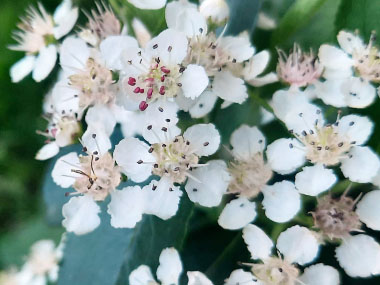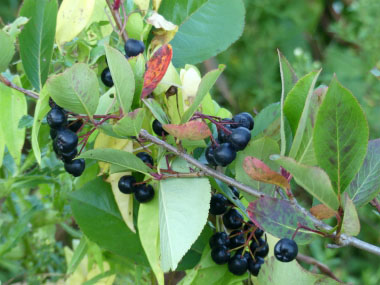








To support our efforts please browse our store (books with medicinal info, etc.).
Black chokeberry is a small to medium sized shrub with an upright, mounded habit. Small clusters of white flowers in spring are followed by glossy black fruit. The high-antioxidant fruit is used in baking and to make jams, jellies, syrup, tea, juice and wine. Fruit can persist into winter and serves as a food source for birds and other wildlife. This shrub is in the rose family and is native to North America.
Trunk/Bark
The bark is brown and relatively smooth, with obvious lenticels.
Branches/Twigs
Twigs of new wood are green initially, turning reddish with age and finally purplish-brown as old stems. Twigs are hairless and with long terminal and lateral buds that have several large scales. The lateral buds form the short stub twigs on which the flower cluster arises.
Height
This upright shrub can grow anywhere from 1 to 2.5 metres (3 to 8') tall. Shrubs can be multi-stemmed and thicket forming. Under optimum conditions these shrubs can grow to over 1.5 metres wide.
Leaves/Needles
Black chokeberry leaves occur alternate, are dark green, glossy with fine-toothed margins. They measure 2.5 to 8 cm (1 to 3”) long. The foliage turns a deep mahogany red in fall.
Flowers
Flowers are 5-parted, showy, around 20 stamens with showy pink to purplish red anthers and with a 5-parted style, all rising from a yellow-green central receptacle. The 5 white petals have narrowed bases. Flower buds appear with the new leaves.
Fruit
Clusters of 6 to 12mm (1/4 to 1/2”) fruit turn purplish-black or black in late summer and autumn.
Habitat
It tends to prefer wet (acidic) soils yet can tolerate occasional drought or flooding. This shrub is in some central areas of Canada and the US but are more common in the eastern areas of both countries. It has naturalized in some other areas including eastern Asia.
Edible Parts
The berries are edible although taste better once baked or made into jelly, syrups, etc. It is believed that they are at their maximum for nutrition after the first frost. Black chokeberries are very high in pectin making them desirable in jellies. These berries contain a wide range of vitamins and minerals, including zinc, magnesium, iron, and vitamins A, C, E, and K.
Other Name
Black Seeded Chokeberry.
Recipes
Aronia Berry Chutney, Aronia Berry Cookies, Coconut Choco-Bites, Aronia Fruit Smoothie, Goldenrod Tea, Aronia Oat Loaf, Aronia Zucchini Bread, Elderberry Pie, Wild Berry Sauce
Winter Survival Food Handbook

PDF Plant Magazines
Types of Wild Food
Geographic Zones Seasons
Disclaimer
EdibleWildFood.com is informational in nature. While we strive to be 100% accurate, it is solely up to the reader to ensure proper plant identification. Some wild plants are poisonous or can have serious adverse health effects.
We are not health professionals, medical doctors, nor are we nutritionists. It is up to the reader to verify nutritional information and health benefits with qualified professionals for all edible plants listed in this web site. Please click here for more information.
Why Edible Wild Food?
- Food costs are rising
- Free, wild food is readily abundant
- Wild food adds nutrition to your diet
- Wild food can help treat various medical conditions





